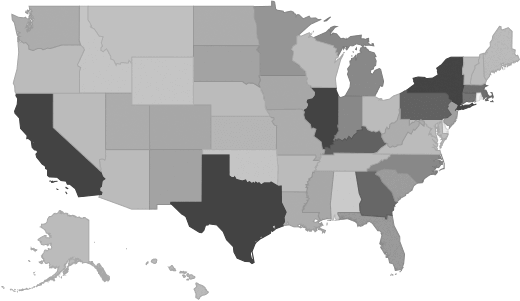Wired Telecommunications Carriers - Market Size, Financial Statistics, Industry Trends
Industry Overview
This U.S. industry comprises establishments primarily engaged in operating, maintaining, and/or providing access to transmission facilities and infrastructure that they own and/or lease for the transmission of voice, data, text, sound, and video using wired telecommunications networks. Transmission facilities may be based on a single technology or a combination of technologies. Establishments in this industry use the wired telecommunications network facilities that they operate to provide a variety of services, such as wired telephony services, including VoIP services; wired (cable) audio and video programming distribution; and wired broadband Internet services. By exception, establishments providing satellite television distribution services using facilities and infrastructure that they operate are included in this industry. Illustrative Examples: Broadband Internet service providers, wired (e.g., cable, DSL) Cable television distribution services Closed-circuit television (CCTV) services Direct-to-home satellite system (DTH) services Local telephone carriers, wired Long-distance telephone carriers, wired Multichannel multipoint distribution services (MMDS) Satellite television distribution systems Telecommunications carriers, wired VoIP service providers, using own operated wired telecommunications infrastructure Cross-References. Establishments primarily engaged in--Source: U.S. Census Bureau
Wired Telecommunications Carriers Market Size
This report includes historical and forecasted market sizes and industry trends for Wired Telecommunications Carriers. It reveals overall market dynamics from 2020 through the present, and predicts industry growth or shrinkage through 2030. Revenue data include both public and private companies in the Wired Telecommunications Carriers industry.| Historical | Forecasted | ||||||||||
|---|---|---|---|---|---|---|---|---|---|---|---|
| 2020 | 2021 | 2022 | 2023 | 2024 | 2025 | 2026 | 2027 | 2028 | 2029 | 2030 | |
| Market Size (Total Revenue) | Included in Report |
||||||||||
| % Growth Rate | |||||||||||
| Number of Companies | |||||||||||
| Total Employees | |||||||||||
| Average Revenue per Company | |||||||||||
| Average Employees per Company | |||||||||||
Industry Revenue ($ Billions)

Industry Forecast ($ Billions)

Pell Research's advanced econometric models forecast five years of industry growth based on short- and long-term trend analysis. Market size statistics include revenue generated from all products and services sold within the Wired Telecommunications Carriers industry.
Geographic Breakdown by U.S. State
Wired Telecommunications Carriers market share by state pinpoints local opportunities based on regional revenue statistics. Growth rate for each state is affected by regional economic conditions. Data by state can be used to locate profitable and nonprofitable locations for Wired Telecommunications Carriers companies in the United States.Industry Revenue by State [Sample]

Distribution by Company Size
| Company Size | All Industries | Wired Telecommunications Carriers |
|---|---|---|
| Small Business (< 5 Employees) | Included |
|
| Small Business (5 - 20) | ||
| Midsized Business (20 - 100) | ||
| Large Business (100 - 500) | ||
| Enterprise (> 500) | ||
Industry Income Statement (Average Financial Metrics)
Financial statement analysis determines averages for the following industry forces:- Cost of goods sold
- Compensation of officers
- Salaries and wages
- Employee benefit programs
- Rent paid
- Advertising and marketing budgets
The report includes a traditional income statement from an "average" Wired Telecommunications Carriers company (both public and private companies are included).
| Industry Average | Percent of Sales | |
|---|---|---|
| Total Revenue | Included |
|
| Operating Revenue | ||
| Cost of Goods Sold (COGS) | ||
| Gross Profit | ||
| Operating Expenses | ||
| Operating Income | ||
| Non-Operating Income | ||
| Earnings Before Interest and Taxes (EBIT) | ||
| Interest Expense | ||
| Earnings Before Taxes | ||
| Income Tax | ||
| Net Profit | ||
Average Income Statement

Cost of Goods Sold
Salaries, Wages, and Benefits
Rent
Advertising
Depreciation and Amortization
Officer Compensation
Net Income
Financial Ratio Analysis
Financial ratios allow a company's performance to be compared against that of its peers.| Financial Ratio | Industry Average |
|---|---|
| Profitability Ratios | Included |
| Profit Margin | |
| ROE | |
| ROA | |
| Liquidity Ratios | |
| Current Ratio | |
| Quick Ratio | |
| Activity Ratios | |
| Average Collection Period | |
| Asset Turnover Ratio | |
| Receivables Turnover Ratio | |
| Inventory Conversion Ratio |
Compensation and Salary Surveys
Salary information for employees working in the Wired Telecommunications Carriers industry.| Title | Percent of Workforce | Bottom Quartile | Average (Median) Salary | Upper Quartile |
|---|---|---|---|---|
| Management Occupations | 5% |
Included |
||
| Chief Executives | 0% | |||
| General and Operations Managers | 1% | |||
| Business and Financial Operations Occupations | 9% | |||
| Business Operations Specialists | 7% | |||
| Computer and Mathematical Occupations | 17% | |||
| Computer Occupations | 17% | |||
| Database and Systems Administrators and Network Architects | 5% | |||
| Computer Support Specialists | 5% | |||
| Sales and Related Occupations | 14% | |||
| Sales Representatives, Services | 10% | |||
| Miscellaneous Sales Representatives, Services | 10% | |||
| Sales Representatives, Services, All Other | 10% | |||
| Office and Administrative Support Occupations | 19% | |||
| Information and Record Clerks | 11% | |||
| Customer Service Representatives | 10% | |||
| Customer Service Representatives | 10% | |||
| Installation, Maintenance, and Repair Occupations | 31% | |||
| Electrical and Electronic Equipment Mechanics, Installers, and Repairers | 22% | |||
| Radio and Telecommunications Equipment Installers and Repairers | 21% | |||
| Telecommunications Equipment Installers and Repairers, Except Line Installers | 21% | |||
| Other Installation, Maintenance, and Repair Occupations | 8% | |||
| Line Installers and Repairers | 7% | |||
| Telecommunications Line Installers and Repairers | 7% | |||
Top Companies in Wired Telecommunications Carriers and Adjacent Industries
| Company | Address | Revenue ($ Millions) |
|---|---|---|
Included |
||
